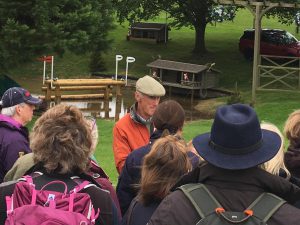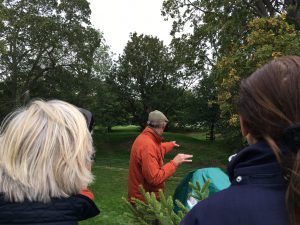“Galloping the Green Strip” Report from Burghley Course Walk with Eric Smiley
 As one approached the second fence on the Burghley 2019 course, the meeting point for the F and I course walk, it was hard to control the excitement at spotting “the flower bed” which was more like a raised bed for a giant. It is only human nature to design courses which you would like to ride yourself and when walking the course you “must think of the psychology of the designer”, in this case Captain Mark Phillips. Eric emphasised Mark always rode forward and boldly to a fence and the result was his courses asked the same from riders. The first three fences left us all in no doubt of that, with the second and third asking the horse to get up in the air over a large box and then open out over a large table, sadly not stopping to drink any of the sponsors champagne at this point…
As one approached the second fence on the Burghley 2019 course, the meeting point for the F and I course walk, it was hard to control the excitement at spotting “the flower bed” which was more like a raised bed for a giant. It is only human nature to design courses which you would like to ride yourself and when walking the course you “must think of the psychology of the designer”, in this case Captain Mark Phillips. Eric emphasised Mark always rode forward and boldly to a fence and the result was his courses asked the same from riders. The first three fences left us all in no doubt of that, with the second and third asking the horse to get up in the air over a large box and then open out over a large table, sadly not stopping to drink any of the sponsors champagne at this point…
Eric reminded us further round the walk of the three buckets which can easily be emptied whilst riding the course and we should seek to keep them as full as we can at all times:
- Confidence
- Energy
- Time
These buckets are related because as we identify one starting to empty it has a negative effect on the next in line. If the horse starts to question what he is doing then we result in loss of Confidence, this in turn results in requiring more Energy from horse to keep in between the flags, thus resulting in Time being wasted setting the horse up for each fence and ultimately we run out of time. As one rides the course it is important to assess how full these buckets are, for example when a horse has an awkward jump/experience through a combination then the rider should assess if the Confidence has been reduced and may choose to take an alternative which refills the bucket.
Time can be easily lost in many areas of the course because of the proximity of the crowds (around the main arena) or trees (Winners Avenue). The whole course was neatly roped off and narrow in many places which can gives the impression of travelling at a greater speed than you are actually moving. It is very important to have clear in your mind that you should be “galloping the green strip” not just out for a canter.
 Anyone who watch the 2018 Tryon WEG cross country would have seen the issues caused by a simple step, changed only by having water cascading from the step. Fence 4 gave the first real question where the middle element of the combination on a curved line had a waterfall and this falling water can be difficult for a horse to read. One can see many of the top riders starting to build extravagant aquatic water features at home as these becomes a popular feature on courses.
Anyone who watch the 2018 Tryon WEG cross country would have seen the issues caused by a simple step, changed only by having water cascading from the step. Fence 4 gave the first real question where the middle element of the combination on a curved line had a waterfall and this falling water can be difficult for a horse to read. One can see many of the top riders starting to build extravagant aquatic water features at home as these becomes a popular feature on courses.
At fences 5, 6, 7 and 8 questions started to be asked of the horse and rider combinations where they were challenged to find the correct line and speed. I was reminded in hindsight having travelled from Edinburgh that jumping is like going on a flight. We, as the pilot, are responsible for finding the runway and setting the speed, but our horse, the plane, is responsible for the flying. Thus, we are not dominating the horse to do as we will but instead giving him responsibility to take an active part in his role. This applies across all the disciplines that we are in charge of the “line and the speed” whether we are approaching the corner of a dressage arena, triple bar to planks or the Leaf Pit at Burghley. Eric emphasised the importance that we facilitate our horse’s learning, where we give him options and he should always seek to choose the correct one i.e. going through the flags with a pole on the ground for a young horse, which leads him on to jumping a skinny brush as seen on both fences 6 and 7.
On leaving the Land Rover Valley for the second time fence 8, riders were then into the main course where questions kept coming thick and fast with little time to have a rest. At most fences there were questions where striding could be discussed till Burghley 2020 and never an answer be found because of the variables:
- How did my horse take off?
- How did he land?
- What did he see mid-air?
The Trout Hatchery, Fence 10, was a prime example as the horse could hang in the air as a result of sighting the water on take-off. This could lead to many landings, short or long, but the rider should be focussed not on the striding but on riding the horse to the spread in the water at which point it is then the horse’s job to get in the air. This said the rider must be an active participant ensuring the horse arrives in an acceptable speed and on the correct line. “Any horse at this level should be able to jump 1.20m out of a few strides of trot” and for those of us who watched the cross country on Saturday, Eric couldn’t have been more correct as we saw many stumbles up the step and the resulting jump over the style being skilfully popped out of trot.
As we travelled on round the course Eric explained the use of safety features which are always of importance because this should be our first priority. At fences 16, gates, and 22, slate mine, it was very obvious the new design in fence building where the ground line is enhanced with box shaped additions to the front of the fence (see picture). It has been realised that the addition of these boxes in this case flowers or stones enhance the horse’s ability to judge the take off point. This aspect of design is very noticeable once pointed out but appears to be only part of the fence presentation. When asked Eric said it is perhaps worth us exploring the use of plastic blocks or flowers in the arena at home when training with horses who have difficulty finding the groundline at a fence.
Having reached the end of the course a huge thank you was given to Eric for his insight on the course and sharing of his thoughts on riding the fences. Whilst fielding questions at the end of our course walk Eric put is money where his mouth was and bet on there being 6 riders inside the time. Fortunately for him only one hand was shaken, or we could have all been a 50p richer by Saturday afternoon.
Report by Richard Johnston-Smith
